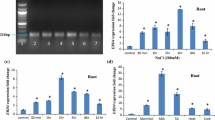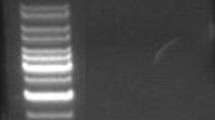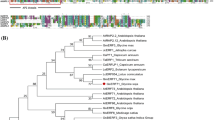Abstract
Contents RNA-binding proteins (RBPs) have been implicated as regulatory proteins involved in the post-transcriptional processes of gene expression in plants under various stress conditions. In this study, we report the cloning and characterization of a gene, designated as EgRBP42, encoding a member of the plant heterogeneous nuclear ribonucleoprotein (hnRNP)-like RBP family from oil palm (Elaeis guineensis Jacq.). EgRBP42 consists of two N-terminal RNA recognition motifs and a glycine-rich domain at the C-terminus. The upstream region of EgRBP42 has multiple light-responsive, stress-responsive regulatory elements and regulatory elements associated with flower development. Real-time RT-PCR analysis of EgRBP42 showed that EgRBP42 was expressed in oil palm tissues tested, including leaf, shoot apical meristem, root, female inflorescence, male inflorescence and mesocarp with the lowest transcript level in the roots. EgRBP42 protein interacted with transcripts associated with transcription, translation and stress responses using pull-down assay and electrophoretic mobility shift assay. The accumulation of EgRBP42 and its interacting transcripts were induced by abiotic stresses, including salinity, drought, submergence, cold and heat stresses in leaf discs. Collectively, the data suggested that EgRBP42 is a RBP, which responds to various abiotic stresses and could be advantageous for oil palm under stress conditions.
Key message EgRBP42 may be involved in the post-transcriptional regulation of stress-related genes important for plant stress response and adaptation.







Similar content being viewed by others
References
Asemota O, Shah FH (2004) Detection of mesocarp oleoyl-thioesterase gene of the South American oil palm Elaeis oleifera by reverse transcriptase polymerase chain reaction. Afr J Biotechnol 3:595–598
Bove J, Kim CY, Gibson CA, Assmann SM (2008) Characterization of wound-responsive RNA-binding proteins and their splice variants in Arabidopsis. Plant Mol Biol 67:71–88
Chattopadhyay S, Puente P, Deng X, Wei N (1998) Combinatorial interaction of light-responsive elements plays a critical role in determining the response characteristics of light-regulated promoters in Arabidopsis. Plant J 15:69–77
Cha-Um S, Takabe T, Kirdmanee C (2010) Osmotic potential, photosynthetic abilities and growth characters of oil palm (Elaeis guineensis Jacq.) seedlings in responses to polyethylene glycol-induced water deficit. Afr J Biotechnol 9:6509–6516
Chen Y, Varani G (2005) Protein families and RNA recognition. FEBS J 272:2088–2097
Cheong YH, Chang H, Gupta R, Wang X, Zhu T, Luan S (2002) Transcriptional profiling reveals novel interactions between wounding pathogen abiotic stress and hormonal responses in Arabidopsis. Plant Physiol 129:1–17
Conesa A, Gotz S, Garcia-Gomez JM, Terol J, Talon M, Robles M (2005) Blast2go, a universal tool for annotation visualization and analysis in functional genomics research. Bioinformatics 21:3674–3676
Corley RHV, Donough CR (1995) Effects of defoliation on sex differentiation in oil palm clones. Exp Agric 31:177–189
Crofts AJ, Crofts N, Whitelegge JP, Okita TW (2010) Isolation and identification of cytoskeleton-associated prolamine mRNA binding proteins from developing rice seeds. Planta 231:1261–1276
Degenhardt J, Tobin EM (1996) A DNA binding activity for one of two closely defined phytochrome regulatory elements in an Lhcb promoter is more abundant in etiolated than in green plants. Plant Cell 8:31–41
Egea-Cortines M, Saedler H, Sommer H (1999) Ternary complex formation between the MADS-box protein SQUAMOSA DEFICIENS and GLOBOSA is involved in the control of floral architecture in Antirrhinum majus. EMBO J 18:5370–5379
Gawankar MS, Devmore JP, Jamadagni BM, Sagvekar VV, Khan HH (2003) Effect of water stress on growth and yield of Tenera oil palm. J Appl Hortic 5:39–40
Glisovic T, Bachorik JL, Yong J, Dreyfuss G (2008) Minireview, RNA-binding proteins and post-transcriptional gene regulation. FEBS Lett 582:1977–1986
Gowik U, Burscheidt J, Akyildiz M, Schlue U, Koczor M, Streubel M, Westhoff P (2004) cis-Regulatory elements for mesophyll-specific gene expression in the C4 plant Flaveria trinervia, the promoter of the C4 phosphoenolpyruvate carboxylase gene. Plant Cell 16:1077–1090
Hall TA (1999) BioEdit, a user-friendly biological sequence alignment editor and analysis program for Windows 95/98/NT. Nucleic Acids Symp Ser 41:95–98
Hellemans J, Mortier G, De Paepe A, Speleman F, Vandesompele J (2007) qBase relative quantification framework and software for management and automated analysis of real-time quantitative PCR data. Genome Biol 8:R19
Jain M, Khurana P, Tyagi AK, Khurana JP (2008) Genome-wide analysis of intronless genes in rice and Arabidopsis. Funct Integr Genomic 8:69–78
Jedamzik B, Eckmann CR (2009) Analysis of RNA-protein complexes by RNA coimmunoprecipitation and RT-PCR analysis from Caenorhabditis elegans. Cold Spring Harbor Protoc 10:pdb.prot5300
Kaneko M, Inukai Y, Ueguchi-Tanaka M, Itoh H, Izawa T, Kobayashi Y, Hattori T, Miyao A, Hirochika H, Ashikari M, Matsuoka M (2003) Loss-of-function mutations of the rice GAMBY gene impair α-amylase expression in aleurone and flower development. Plant Cell 16:33–44
Kim CY, Bove J, Assmann SM (2008) Overexpression of wound-responsive RBPs induces leaf senescence and hypersensitive-like cell death. New Phytol 180:57–70
Kim JY, Kim WY, Kwak KJ, Oh SH, Han YS, Kang H (2010) Glycine-rich RNA-binding proteins are functionally conserved in Arabidopsis thaliana and Oryza sativa during cold adaptation process. J Exp Bot 61:2317–2325
Kwak KJ, Park SJ, Kim MK, Oh SH, Han YS, Kang H (2011) Structural determinants crucial to the RNA chaperone activity of glycine-rich RNA-binding proteins 4 and 7 in Arabidopsis thaliana during the cold adaptation process. J Exp Bot 62:4003–4011
Lambermon MHL, Simpson GG, Kirk DA, Hemmings-Mieszczak M, Klahre U, Filipowicz W (2000) UBP1 a novel hnRNP-like protein that functions at multiple steps of higher plant nuclear pre-mRNA maturation. EMBO J 19:1638–1649
Lambermon MHL, Fu Y, Kirk DAW, Dupasquier M, Filipowicz W, Lorkovic ZJ (2002) UBA1 and UBA2 two proteins that interact with UBP1 a multifunctional effector of pre-mRNA maturation in plants. Mol Cell Biol 22:4346–4357
Lee M, Kim KP, Kim B, Hahn J, Hong CB (2009) Flooding stress-induced glycine rich RNA-binding protein from Nicotiana tabacum. Mol Cells 27:47–54
Li J, Kinoshita K, Pandey S, Ng CK, Gygi SP, Shimazaki K, Assmann SM (2002) Modulation of an RNA-binding protein by abscisic-acid-activated kinase. Nature 418:793–797
Lindlof A, Brautigam M, Chawade A, Olsson O, Olsson B (2009) In silico analysis of promoter regions from cold-induced genes in rice Oryza sativa L. and Arabidopsis thaliana reveals the importance of combinatorial control. Bioinformatics 25:1345–1348
Lipman DJ, Souvorov A, Koonin EV, Panchenko AR, Tatusoba TA (2002) The relationship of protein conservation and sequence length. BMC Evol Biol 2:20
Lorkovic ZJ (2009) Review: role of plant RNA-binding proteins in developmental stress response and genome organization. Trends Plant Sci 14:229–236
Lorkovic ZJ, Barta A (2002) Survey and summary: genome analysis: RNA recognition motif (RRM) and K homology (KH) domain RNA-binding proteins from the flowering plant Arabidopsis thaliana. Nucleic Acids Res 30:623–635
Lorkovic ZJ, Wieczorek Kirk DA, Klahre U, Hemmings-Mieszczak M, Filipowicz W (2000) RBP45 and RBP47, two oligouridylate-specific hnRNP-like proteins interacting with poly(A) + RNA in nuclei of plant cells. RNA 6:1610–1624
Macknight R, Bancroft I, Page T, Lister C, Schmidt R, Love K, Westphal L, Murphy G, Sherson S, Cobbett C, Dean C (1997) FCA, a gene controlling flowering time in Arabidopsis, encodes a protein containing RNA-binding domains. Cell 89:737–745
Murray MG, Thompson WF (1980) Rapid isolation of high molecular weight plant DNA. Nucleic Acids Res 8:4321–4326
Peal L, Jambunanthan N, Mahalingam R (2011) Phylogenetic and expression analysis of RNA-binding proteins with triple RNA recognition motifs in plants. Mol Cells 31:55–64
Quesada V, Macknight R, Dean C, Simpson GG (2003) Autoregulation of FCA pre-mRNA processing controls Arabidopsis flowering time. EMBO J 22:3142–3152
Razem FA, El-Kereamy A, Abrams SR, Hill RD (2006) The RNA-binding protein FCA is an abscisic acid receptor. Nature 439:290–294
Schoning JC, Streitner C, Page DR, Hennig S, Uchida K, Wolf E, Furuya M, Staiger D (2007) Auto-regulation of the circadian slave oscillator component AtGRP7 and regulation of its targets is impaired by a single RNA recognition motif point mutation. Plant J 52:1119–1130
Smith B, Williams J, Steffen S (2003) The ontology of the gene ontology. AMIA Annu Symp Proc 2003:609–613
Staiger D, Zecca L, Kirk DAW, Apel K, Eckstein L (2003) The circadian clock regulated RNA-binding protein AtGRP7 autoregulates its expression by influencing alternative splicing of its own pre-mRNA. Plant J 33:361–371
Swindell WR, Huebner M, Weber AP (2007) Transcriptional profiling of Arabidopsis heat shock proteins and transcription factors reveals extensive overlap between heat and non-heat stress response pathways. BMC Genomics 8:1–15
Tamura K, Dudley J, Nei M, Kumar S (2007) MEGA4, a molecular evolutionary genetic analysis MEGA software version 4.0. Mol Biol Evol 24:1597–1599
Terzaghi WB, Cashmore AR (1995) Light regulated transcription. Annu Rev Plant Physiol Plant Mol Biol 46:445–474
Thompson JD, Higgins DG, Gibson TJ (1994) CLUSTAL W: improving the sensitivity of progressive multiple sequence alignment through sequence weighting, position specific gap penalties and weight matrix choice. Nucleic Acids Res 22:4673–4680
Vandesompele J, De Preter K, Pattyn F, Poppe B, Van Roy N, De Paepe A, Speleman F (2002) Accurate normalization of real-time quantitative RT-PCR data by geometric averaging of multiple internal control genes. Genome Biol 3:research0034
Wang B, Brendel V (2004) The ASRG database, Identification and survey of Arabidopsis thaliana genes involved in pre-mRNA splicing. Genome Biol 5:R102
Winicov I (2000) Alfin1 transcription factor overexpression enhances plant root growth under normal and saline conditions and improves salt tolerance in alfalfa. Planta 210:416–422
Acknowledgments
This study was financially supported by Sime Darby Plantation. The authors thank SDR Banting for the oil palm samples, Dr. Mohd Nazir Basiran, Mr. Wong Yick Ching and Mdm. Lee Fong Chin for helpful discussion. The authors also would like to thank Mdm. Alena Lee Sanusi and Dr. Mohd Sanusi Jangi for useful editorial comments on the manuscript.
Author information
Authors and Affiliations
Corresponding author
Additional information
Communicated by J. Bennett.
Electronic supplementary material
Below is the link to the electronic supplementary material.
Rights and permissions
About this article
Cite this article
Yeap, WC., Ooi, T.E.K., Namasivayam, P. et al. EgRBP42 encoding an hnRNP-like RNA-binding protein from Elaeis guineensis Jacq. is responsive to abiotic stresses. Plant Cell Rep 31, 1829–1843 (2012). https://doi.org/10.1007/s00299-012-1297-x
Received:
Accepted:
Published:
Issue Date:
DOI: https://doi.org/10.1007/s00299-012-1297-x




